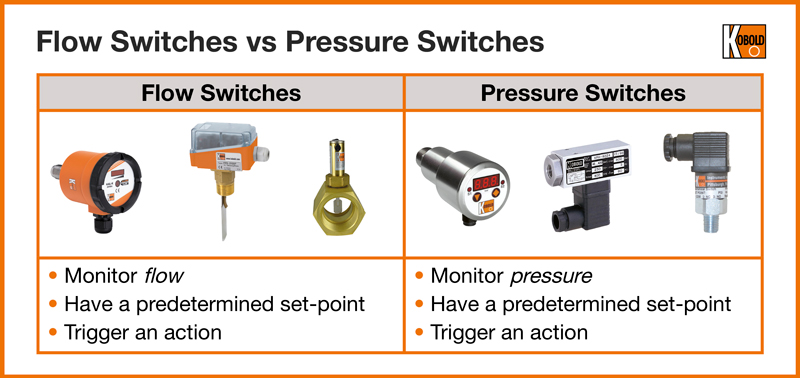What is a Flow Switch?
A flow switch is simply a device that monitors the flow of liquid, gas, or steam. When the flow reaches a certain pre-set flow rate, a switch is triggered that has the capability to signal an action, such as shutting down the flow entirely. This is done through electrical signals created by the switching mechanism. In principle, flow switches are similar to a light switch. They just happen to be in a stream of flow and do not require that a person be physically present to turn them off and on.
Flow switches can handle a wide variety of different media running through them, but by far, the most common media for flow switches are water and air.

What is the Difference between a Flow Meter and a Flow Switch?
Flow switches can either be simple stand-alone units that do nothing but monitor flow rates and trigger at a specified flow rate, or they can also be found as an integral element of a flow meter. Flow meters provide a continuous measurement of the flow rate and can also provide other functions essential to certain applications through integral electronics, like batching and totalizing.
Not all flow meters offer switching capacity, but it is important to note that for certain application areas, a flow meter with a switch may be the best choice because the flow meter can offer certain advantages for application specifications. For example, a simple flow switch may not offer high enough temperature specifications, but there may be a flow meter with an integral switch that can handle the high temperature.
Because flow meters are generally more expensive than simple flow switches, it is usually best to investigate stand alone flow switches first to see if there is one that can meet your application specifications. If there is not, then a flow meter that offers an integral switch may be the answer.

What is the Difference between a Flow Switch and a Pressure Switch?
A flow switch monitors the flow rate of the media moving through a process line and a pressure switch monitors the pressure within a process line or pipe or vessel. Both pressure switches and flow switches essentially perform the same function, acting as a trigger for a function. They just monitoring different elements of an application. Pressure switches are used in many common places, like the air compressor you may have in your garage. They are also commonly used in pneumatics and hydraulics where force to move something is created by pressurizing a liquid or a gas.

What are the Types of Flow Switches?
Flow switches are primarily classified by the media that they are monitoring (like air or water) the principle of operation, their installation method, and particular application areas. Many flow switches are versatile in that they can meet the needs of many applications. Below are some explanations of different types of flow switches.
Each type of flow switch will offer different advantages and drawbacks. Avoid costly errors down the road by making sure you have chosen the right flow switch for the job. Make use of our free expertise and let us do the work of choosing the right flow switch for your application and your budget.
What is a Water Flow Switch?
Water flow switches are plentiful and used in many different places. Most switches that are built for liquids can be used as water flow switches. KOBOLD offers a wide variety of water flow switches, including all metal versions for high pressures, low flow water switches, and plastic flow switches. We offer both inline and insertion water flow switches. Our available technology types for water include variable area, thermal, and paddle flow switches.
